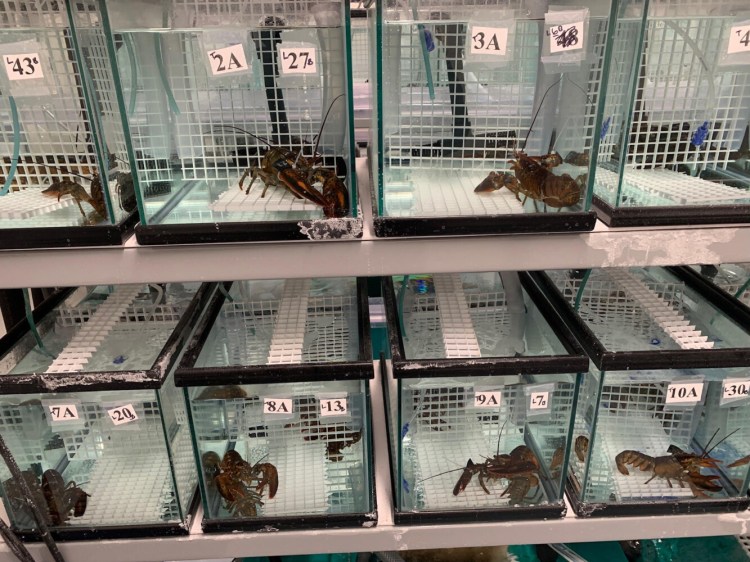Lobsters living in ocean water as warm and acidic as the Gulf of Maine is expected to be by the end of this century will be less able to cope with stress or fight off disease, according to University of Maine researchers who are studying the impacts of the gulf’s changing environment.
While higher water temperatures and acidification both seem to hurt lobsters’ heart function and immune response individually, researchers Amalia Harrington, Robert Harrington, Deborah Bouchard and Heather Hamlin found the combined impact of both likely end-of-century environmental conditions would leave lobsters especially vulnerable.
“Our work is unique because we focused on understanding both the individual and interactive effects of two important environmental stressors, warming and acidification,” said Harrington. “Changes in their physiology to respond to these stressors could result in trade-offs … potentially impacting their success as adult lobsters in this important fishery.”
The Gulf of Maine has been warming rapidly as the deep-water currents that feed it have shifted. It has warmed faster than anyplace else on the planet since 2004, except for an area northeast of Japan, and during the “Northwest Atlantic Ocean heat wave” of 2012, average water temperatures hit the highest level in the 150 years that humans have been recording them.
By 2100, scientists estimate, surface pH levels will be lower – that is, more acidic – than at any time in the past 300 million years, two or three times more so than today. The Gulf of Maine is particularly vulnerable because its colder water more readily absorbs carbon dioxide, and because increasing frequency of snow and rain flood it with more acidic river runoff.
Maine’s fisheries economy is also especially vulnerable, as it depends on species that may not thrive in a more acidic gulf, such a shell-builders. Eighty-seven percent of the value of Maine’s commercial fish catch comes from creatures that have shells, including lobsters, clams, scallops and oysters.
Researchers studied how young female lobsters exposed to projected end-of-century Gulf of Maine conditions – 68 degrees instead of today’s average of 60, with a pH of 7.7 instead of 8 – coped with a stressful event like a sudden heat wave and fought off a disease like gaffkemia, a wasting disease that once bedeviled Maine’s lobster pound operators.
They used a hand drill and needle to puncture each lobster’s shell, insert two electrodes into the chest cavity and run a small current through the heart to watch as it contracted and relaxed to see how the lobster managed the two-hour heat wave, in which the water was gradually heated up to almost 88 degrees.
Not surprisingly, none of the lobsters loved the heat wave. Those that had been kept in warmer tanks fared a little better than lobsters in more acidic tanks, most likely due to acclimation. But the lobsters that had been living in water that was both warmer and more acidic – the “double-whammy” group – saw significantly lower heart function than single-variable lobsters.
Researchers chose to stress out their lobsters with a heat wave, like scientists often do when they want to measure changes in heart function, but they could have easily chosen to tinker with salinity or oxygen levels in the tanks, like what live lobsters can experience during overseas transport to foreign markets.
The researchers turned their attention next to the lobsters’ immune systems. Acidification appeared to have little impact on a lobster’s hemocytes, the part of their blood that helps fight disease, but the warm waters did, suggesting to researchers that the lobsters that had been living in the 68-degree tanks might have a weaker immune response.
So they injected the lobsters with the gaffkemia pathogen, which can cause loss of limbs and death. Their theory held up: Warm-water lobsters died five days sooner than lobsters in the control group. That disease vulnerability was compounded by the effects of acidification – twice as many “double-whammy” lobster lobsters lost a claw than any single-stressor lobster.
“This in no way implies our lobster populations are on the verge of collapse,” said Hamlin, an associate professor of aquaculture and marine sciences. “It does suggest we need to continue to be vigilant in surveying our lobsters for disease outbreaks, and the possibility of other stressors.”
The study, funded by grants from the U.S. National Oceanic and Atmospheric Administration and National Science Foundation, was published on June 20 in the Journal of Crustacean Biology. The nine-month research project was conducted at the Aquaculture Research Center at UMaine’s Orono campus.
Send questions/comments to the editors.




Success. Please wait for the page to reload. If the page does not reload within 5 seconds, please refresh the page.
Enter your email and password to access comments.
Hi, to comment on stories you must . This profile is in addition to your subscription and website login.
Already have a commenting profile? .
Invalid username/password.
Please check your email to confirm and complete your registration.
Only subscribers are eligible to post comments. Please subscribe or login first for digital access. Here’s why.
Use the form below to reset your password. When you've submitted your account email, we will send an email with a reset code.